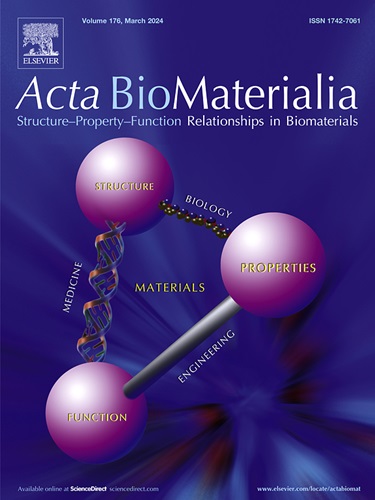结合水凝胶的三维多孔网络的多尺度增材制造,用于持续的体外组织生长。
IF 9.4
1区 医学
Q1 ENGINEERING, BIOMEDICAL
引用次数: 0
摘要
开发高保真三维(3D)组织模型可以最大限度地减少临床医学和药物开发对动物模型的需求。然而,由于扩散过程有效距离的物理限制,此类构建体的大小受到了限制。这是因为较大尺寸的构建体会出现坏死,特别是在其中心,原因是居住在构建体深处的细胞得不到足够的氧气和营养。这阻碍了组织的体外持续生长,而这正是实现功能性微组织所必需的。为了应对这一挑战,我们使用了三种三维打印技术来创建不同长度尺度的可灌注网络,并将其集成到此类构建体中。为了实现这一目标,我们使用熔融沉积建模、立体光刻和双光子聚合技术设计并制造了具有日益复杂结构的多孔导管网络,同时优化了每种技术的打印条件。此外,在将网络嵌入水凝胶后,还采用了造影剂增强微计算机断层扫描和共聚焦荧光显微镜来表征网络的基本功能之一,即扩散功能。研究揭示了各种设计参数对多孔导管 24 小时内扩散行为的影响。我们发现,孔隙数量对造影剂的扩散行为影响最大,其次是孔隙大小和水凝胶浓度的变化。本研究的分析方法和发现为一个新的技术平台奠定了坚实的基础,该平台可用于制造具有复杂设计的可灌注多尺度三维多孔网络,同时还能定制扩散特性,以满足体外组织持续生长的特定要求。意义说明:这项研究解决了当前三维组织工程学的一个重要局限,即通过优化营养和氧气输送来维持较大构建体的组织活力。通过利用先进的三维打印技术,这项研究提出了制造可灌注、多尺度和可定制的网络,以增强扩散并使细胞能够在整个构建体中获得必需的营养物质。研究结果强调了网络特性对模型化合物在水凝胶基质中扩散的作用。这项工作为创建先进的体外三维组织模型提供了一个前景广阔的技术平台,可以减少动物模型在组织再生、疾病模型和药物开发研究中的使用。本文章由计算机程序翻译,如有差异,请以英文原文为准。

Multi-scale additive manufacturing of 3D porous networks integrated with hydrogel for sustained in vitro tissue growth
The development of high-fidelity three-dimensional (3D) tissue models can minimize the need for animal models in clinical medicine and drug development. However, physical limitations regarding the distances within which diffusion processes are effective impose limitations on the size of such constructs. That is because larger-size constructs experience necrosis, especially in their centers, due to the cells residing deep inside such constructs not receiving enough oxygen and nutrients. This hampers the sustained in vitro growth of the tissues which is required for achieving functional microtissues. To address this challenge, we used three types of 3D printing technologies to create perfusable networks at different length scales and integrate them into such constructs. Toward this aim, networks incorporating porous conduits with increasingly complex configurations were designed and fabricated using fused deposition modeling, stereolithography, and two-photon polymerization while optimizing the printing conditions for each of these technologies. Furthermore, following network embedding in hydrogels, contrast agent-enhanced micro-computed tomography and confocal fluorescence microscopy were employed to characterize one of the essential network functionalities, namely the diffusion function. The investigations revealed the effects of various design parameters on the diffusion behavior of the porous conduits over 24 h. We found that the number of pores exerts the most significant influence on the diffusion behavior of the contrast agent, followed by variations in the pore size and hydrogel concentration. The analytical approach and the findings of this study establish a solid base for a new technological platform to fabricate perfusable multiscale 3D porous networks with complex designs while enabling the customization of diffusion characteristics to meet specific requirements for sustained in vitro tissue growth.
Statement of significance
This study addresses an essential limitation of current 3D tissue engineering, namely, sustaining tissue viability in larger constructs through optimized nutrient and oxygen delivery. By utilizing advanced 3D printing techniques this research proposes the fabrication of perfusable, multiscale and customizable networks that enhance diffusion and enable cell access to essential nutrients throughout the construct. The findings highlighted the role of network characteristics on the diffusion of a model compound within a hydrogel matrix. This work represents a promising technological platform for creating advanced in vitro 3D tissue models that can reduce the use of animal models in research involving tissue regeneration, disease models and drug development.
求助全文
通过发布文献求助,成功后即可免费获取论文全文。
去求助
来源期刊

Acta Biomaterialia
工程技术-材料科学:生物材料
CiteScore
16.80
自引率
3.10%
发文量
776
审稿时长
30 days
期刊介绍:
Acta Biomaterialia is a monthly peer-reviewed scientific journal published by Elsevier. The journal was established in January 2005. The editor-in-chief is W.R. Wagner (University of Pittsburgh). The journal covers research in biomaterials science, including the interrelationship of biomaterial structure and function from macroscale to nanoscale. Topical coverage includes biomedical and biocompatible materials.
 求助内容:
求助内容: 应助结果提醒方式:
应助结果提醒方式:


